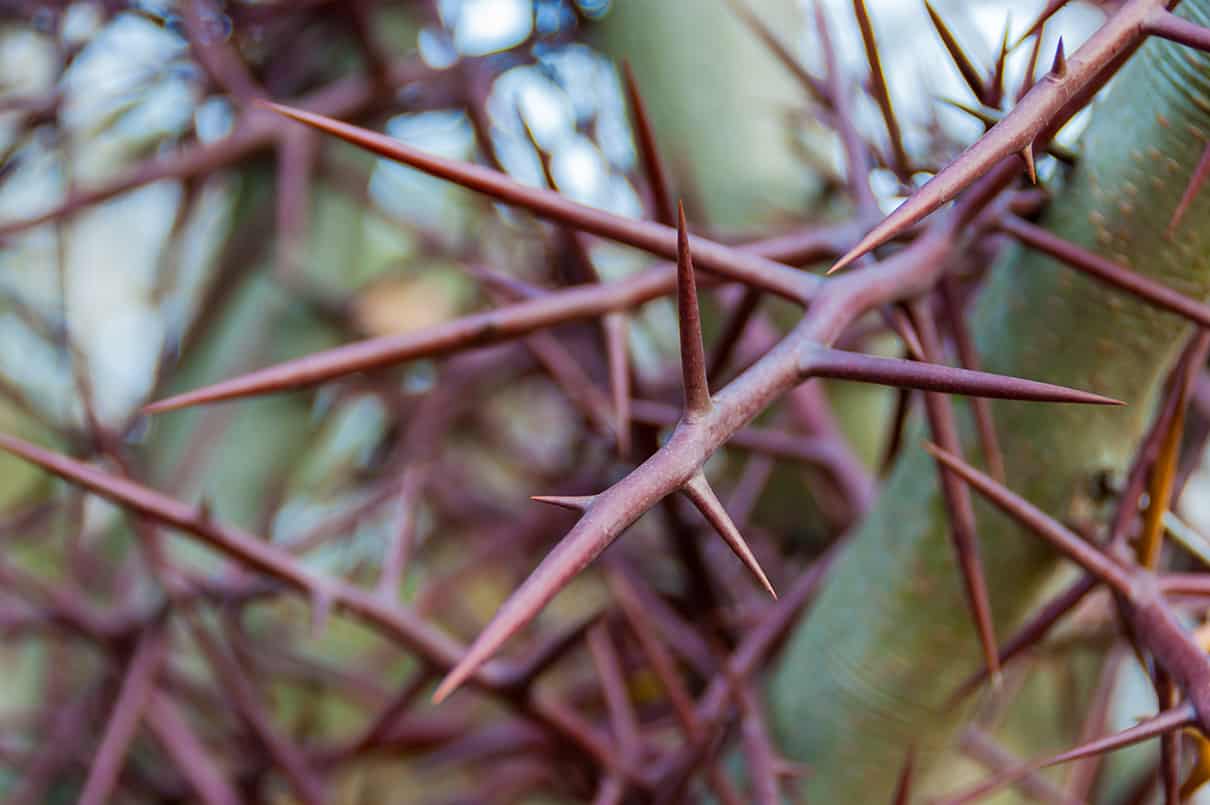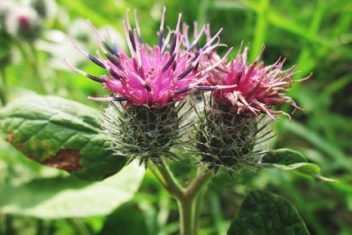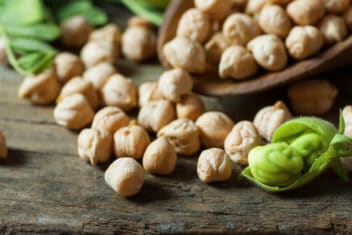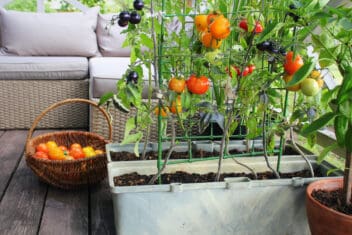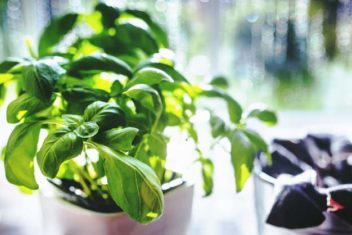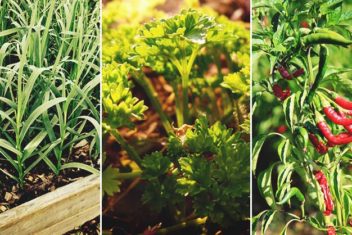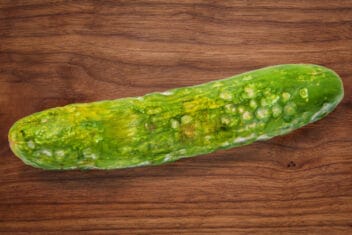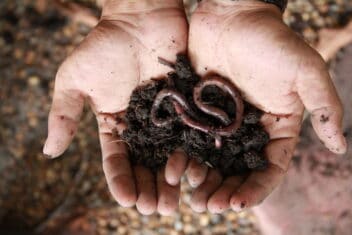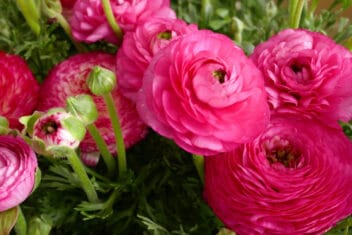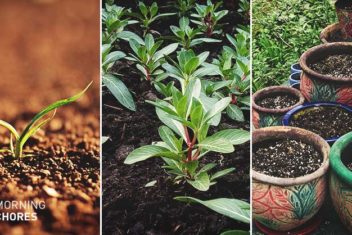Natural plant barriers made up of defensive plants have been used for hundreds of years as a source of protection against animals and intruders.
People use strong, spiky plants instead of modern fencing to keep animals in certain areas. Defensive plants are also used to protect houses and property and to mark borders.
Using plants makes sense when you don’t want fences with razor wire, lights, or other obvious deterrents but want to maintain a natural look and still keep people or animals out.
Let’s look at some of the plant options and their applications around your property.
The Top Defensive Plant Picks
These defensive plants can be used in a variety of ways to protect you and your loved ones, as well as your garden.
Use them on the perimeters of your property to create an impenetrable barrier, or place them under windows and against walls and in window boxes to deter people from entering your home.
Try creating a natural fence around your garden to deter deer and other unwanted visitors.
1. Agave
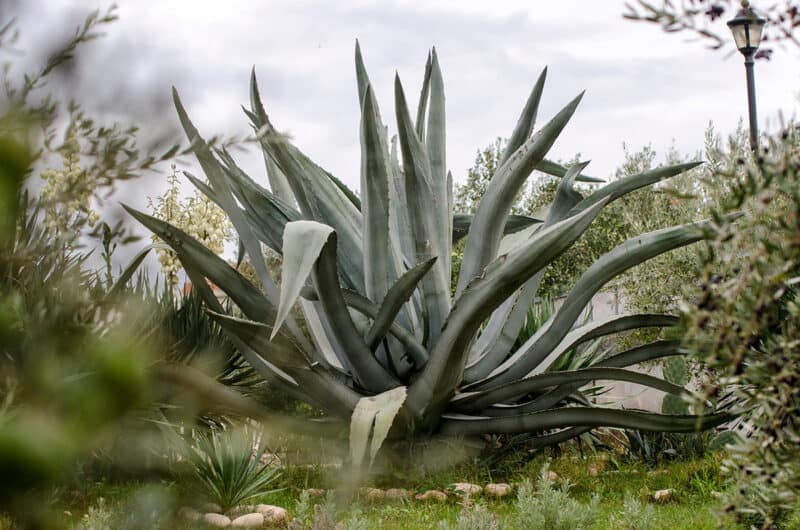
Agave (Agave americana) is a succulent that can be slow-growing, but once it’s established, it will take up plenty of space and create a barrier that is difficult to get through.
This architectural plant is perfect along fence lines or under windows. The leaves are spiny or serrated, and the end forms a very sharp point and hurts when it pierces the flesh.
Sometimes the sharp point breaks off and embeds itself deep in the skin. Just imagine what it can do if it pokes you in the eye. In other words, it provides effective protection, and when you’re maintaining your garden, be careful!
Growing Requirements: Agave is native to Mexico and in the South Western United States. It thrives in USDA Zones 8-11.
It needs free-draining soil with full sun. Agave is drought tolerant, but water regularly for a healthy, swiftly growing plant.
2. Barberry
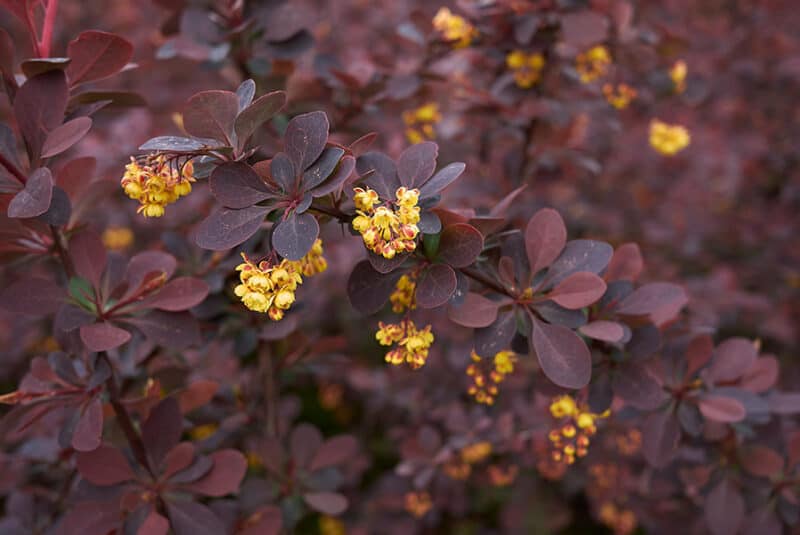
Barberry (Berberis) has a dense growth habit and lots of painful thorns, making it ideal as a natural razor wire. Use it as a fence or surrounding your home.
These pretty plants are incredibly popular in the US thanks to their vibrant color and deer-repellant nature.
Growing Requirements: This is a forgiving plant that can handle sun or partial shade. They grow in zones 4-8 and come in a range of colors, including green, bright yellow, and deep red.
3. Blackberry
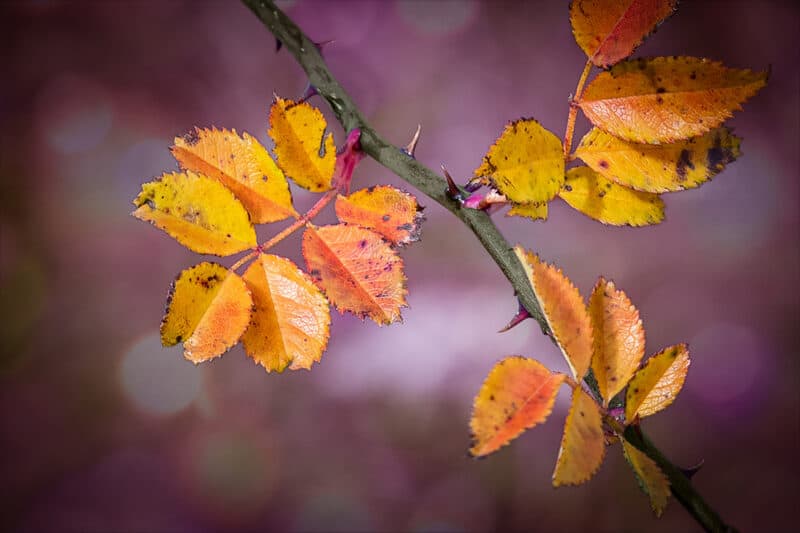
I consider blackberries (Rubus) to be a ‘plant-and-go’ type of option because once it’s in the ground, it will quickly take over the area.
Combine this growth speed with the multiple thorns covering every inch of this plant, and you have the perfect defensive barrier. No one would dare to walk through a blackberry patch.
Depending on your garden type, blackberry plants may not suit being close to the house due to their messy look, but they can certainly be planted around barns, sheds, and anywhere else you want to keep people away from.
The thorns of blackberry are so sharp; I find any gloves useless against them. You will see this when you harvest the berries. No matter how hard you try, you will end up being cut by this plant. It’s very effective as a deterrent.
Growing Requirements: Blackberries are suitable in zones 5-11, and some are even okay down to zone 3. Check on your local varieties, but make sure you don’t get a hybridized thorn-less variety.
Blackberries love sun and water but don’t like wet feet. Ensure the soil can retain moisture but also drains well after watering or rain.
Keep in mind that some cultivars of these plants can become invasive.
4. Blackthorn

Blackthorn (Prunus spinosa), also known as sloe, is a good defensive plant option because it does double duty. Beyond protecting your abode, they also grow berries that you can use to create sloe gin.
Make that triple duty if you enjoy masses of fragrant flowers in the spring.
The sloe tree gets about 12 feet tall
Growing Requirements: The plant needs full sun to partial shade and grows in zones 4-8. It can tolerate road salt and clay soil, which makes it perfect for places where some other plants might not be so happy, like roadsides.
5. Bougainvillea
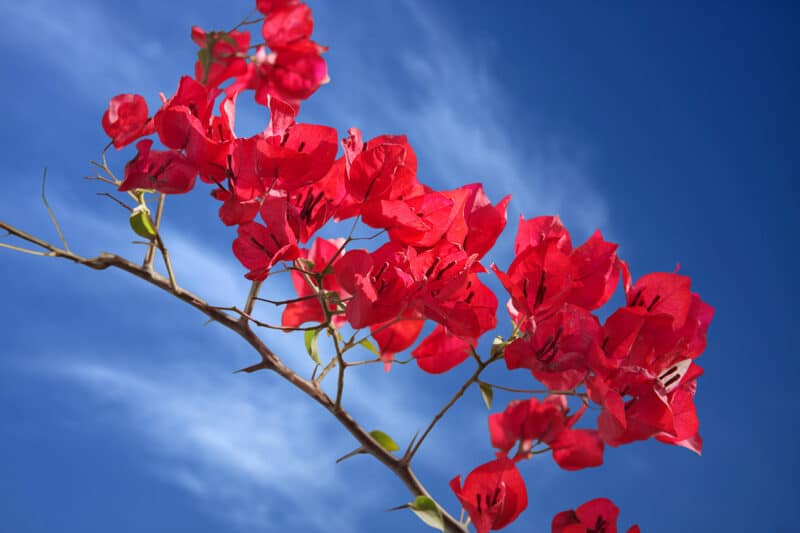
Bougainvillea (Bougainvillea) are packed with vibrant, papery flowers… and extremely painful thorns.
These tropical vines make a low maintenance ground cover or a decorative element for walls or arbors.
They’d be perfect for growing along a fence to deter people or animals from trying to climb over.
Growing Requirements: Bougainvillea prefers full sun and doesn’t mind some drought. It grows as a perennial in zones 9-11 and as an annual in other areas.
6. California Fuchsia
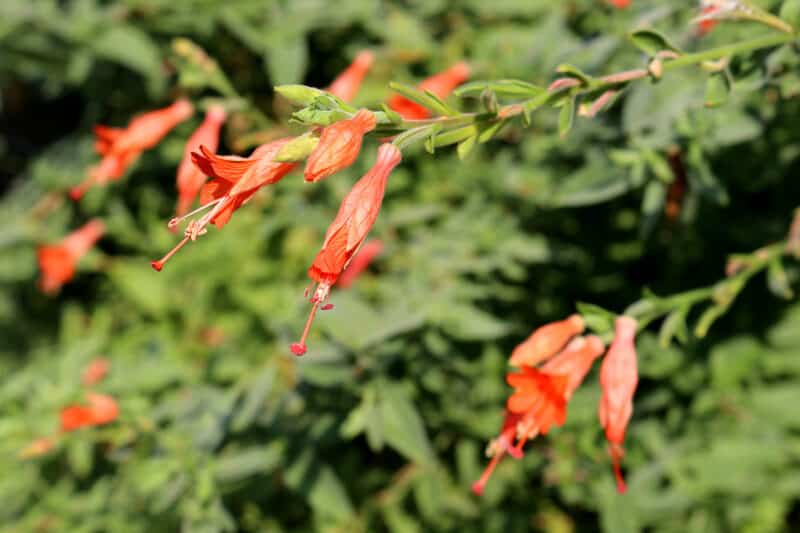
Native to California, this plant will grow up to nine feet tall, or you can keep it pruned into a hedge.
The spiny stems are incredibly sharp, so be careful where you plant Californian fuchsia (Epilobium canum). They’ll keep intruders out, but they might also keep you away from pruning.
If you have a shady part of the garden you want to protect, this plant will suit as it doesn’t mind shade. I find it perfect for filling spaces that someone could squeeze through. No one would push through this plant because the spines are impossible to avoid.
Growing requirements: This plant will thrive in both sunny and shaded areas of zone 7 and above.
Good quality soil and regular watering keep California fuchsia looking green and healthy all year long.
7. Chinese Jujube
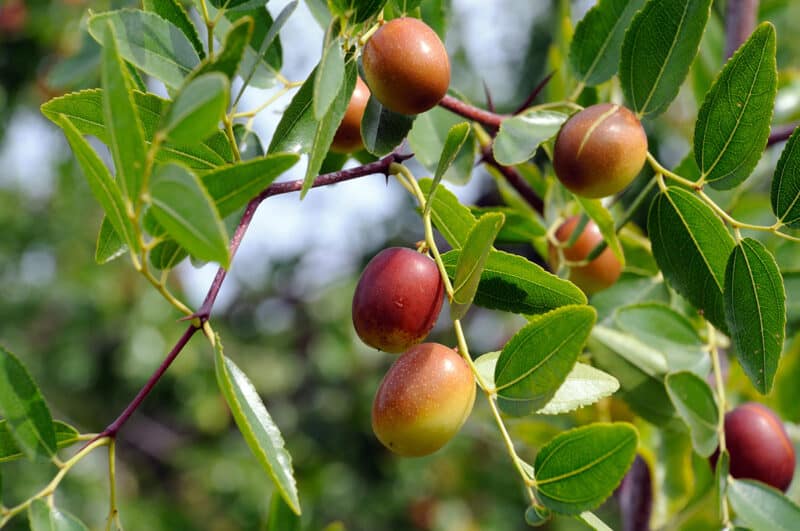
This buckthorn family member is also known as Chinese date (Ziziphus jujuba). It makes an interesting garden specimen, featuring shiny green foliage and flaky, light gray bark.
It also grows tasty fruits, which is sweet and chewy, kind of like dates. They’re often dried and used as candies.
Use this short tree as a deterrent around fields or near your home.
Growing Requirements: These plants like warm, dry climates and sandy, well-draining soil.
These plants grow well in zones 6-10, but can even grow down to zone 5 with a little extra care.
They get up to 30 feet tall when mature, but many stay down to 15 feet.
8. Cholla Cactus
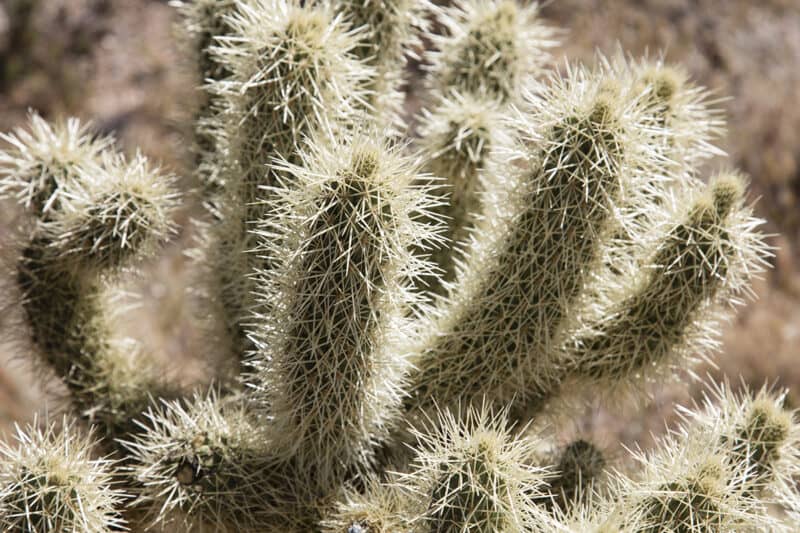
If there were only one defensive plant I could use around my home, cholla cactus (Cylindropuntia) would be it on account of the way it looks.
Covered in extremely sharp spines that detach and stick into clothing and flesh, they look uninviting and a challenge for any would-be intruder.
Cholla cactus work well under windows, against walls, and in gardens. You can plant one or have dozens and they don’t become invasive. Combine them with other types of cactus of various heights, and you’ll have an effective barrier to stop people.
Growing requirements: Like all cactus, cholla cactus need dry and arid conditions to thrive. They suit zones 8 and above.
Cholla cacti like dry soil and feet, so water infrequently. Too much water will kill them off.
There are several different cultivars out there, so you can find some that grow as low as a foot and some as tall as 15 feet.
9. Crown of Thorns

The crown of thorns (Euphorbia milii) is so-called because it’s said to have been the crown of thorns worn by Jesus when he was crucified; this plant is also known as Christ Plant or Christ Thorn.
At an average fully grown height of six feet, crown of thorns is great around borders and boundaries where you don’t require a clear field of sight. You can plant this under windows if you’re happy to prune to shape or don’t mind the window being covered as well.
Plant in containers to protect deck entry points, or to line steps to ensure people walk where you want them to.
Lovely flowers colored red, white or pink are often blooming all year round, but underneath that, the thorns are plentiful and vicious.
Growing Requirements: Crown of Thorns grows well in zones 9-11.
Don’t over-water or root rot will be a problem. Full sun and well-draining soil help this plant flourish.
Be wary when you prune crown of thorns because the sap can cause skin irritation. Use gloves and protective eyewear.
10. Devil’s Walking Stick
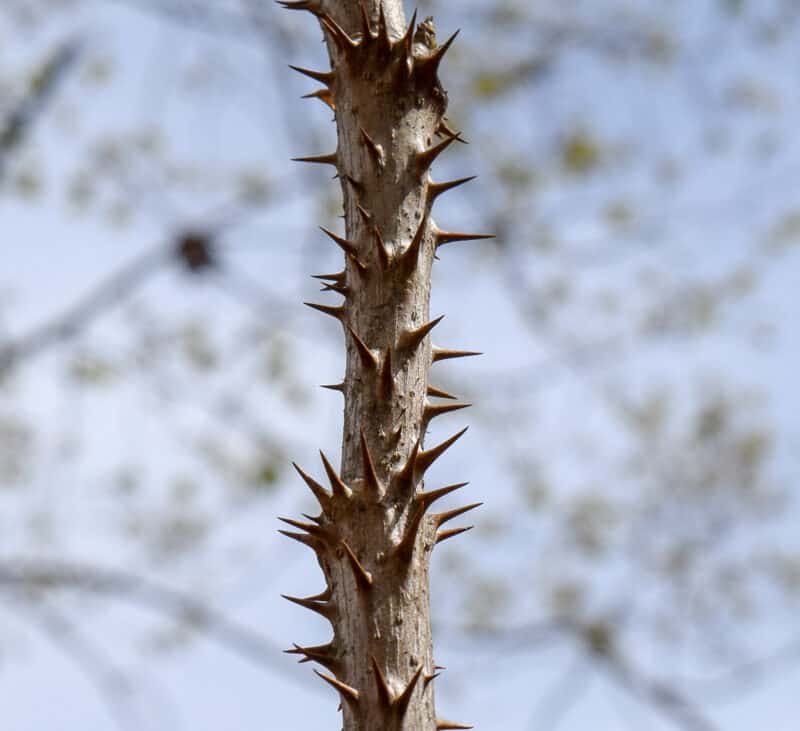
Devil’s walking stick (Aralia spinosa) is perfect if you have a large property and there is an area vulnerable as an entry point for intruders a good distance away from the house.
Keep this relative of ginseng pruned, or it will grow up to 20 feet tall. It loses its leaves in winter when it looks straggly and unattractive. That’s why it’s best away from the house in an area you don’t see, but want to protect.
Devils walking stick will self-seed and spread to fill a large area.
Growing Requirements: This plant does well in zones 4-9.
Devil’s walking stick needs well-draining soil. Sun can be full or partial throughout the day.
11. Giant Rhubarb
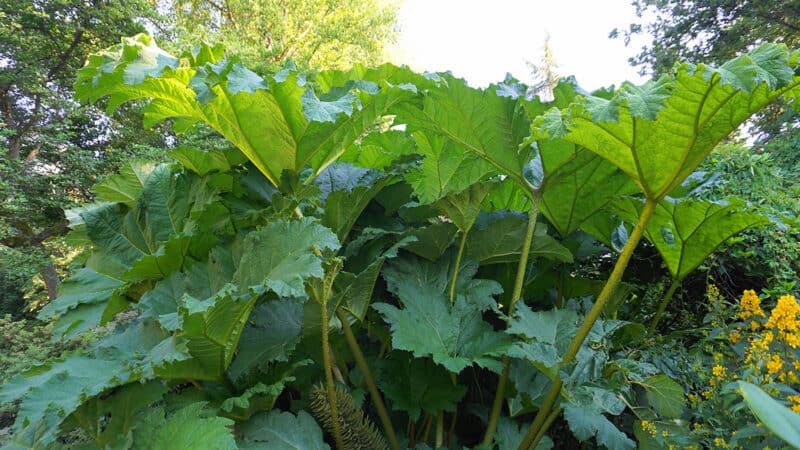
Nope, this isn’t just an extra-large version of the leafy garden veg. It’s a South America native that has been introduced – and has become invasive – in many parts of the world.
It can get six feet tall with massive, leathery leaves that feature vicious spikes on the underside and along the stem.
It spreads rapidly through rhizomes, so don’t put this anywhere where you don’t want it to take over. Trust me, you don’t want to have to pull these pretty-but-nasty leaves too often.
Growing Requirements: If you need a plant for a wet area, this is a good option. It doesn’t mind damp or boggy soil. It’s hardy down to zone 7 and needs partial shade.
12. Hardy Orange
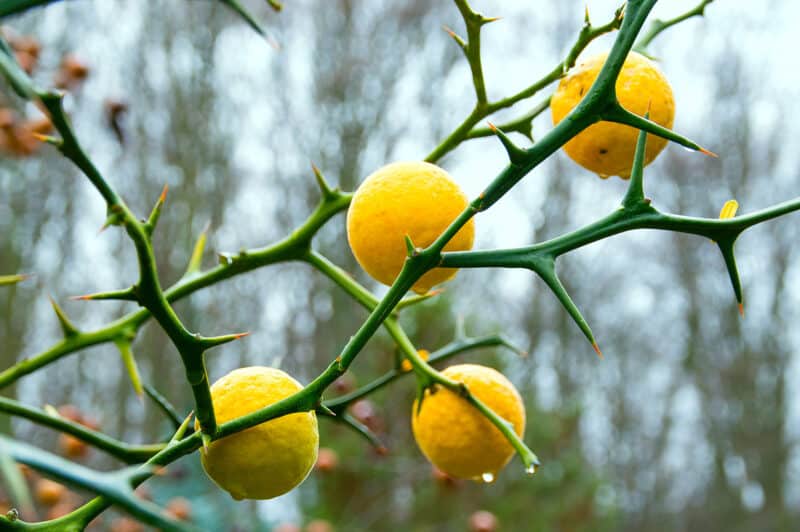
Hardy orange (Citrus trifoliata) is a unique looking, thorny citrus. Its edible fruit is sour, but can be used for making marmalade.
This defensive plant has thick, twisted branches and has long, sharp spikes. It grows up to 20 feet tall but can be pruned regularly into a hedge ready to stab anyone trying to climb or squeeze through.
There is a smaller variety called ‘Flying Dragon,’ which grows to five feet tall. With effective pruning, you can grow an extremely impenetrable hedge.
In the winter, hardy orange loses its leaves, but you will still see green branches and stems, with many spikes.
Hardy orange is a perfect perimeter plant, and you can use it as a fence to keep stock confined.
Growing Requirements: Hardy orange suits zones 5-9, and it’s cold tolerant. Give these plants good sandy, and loamy soil with drainage works well.
13. Hawthorn
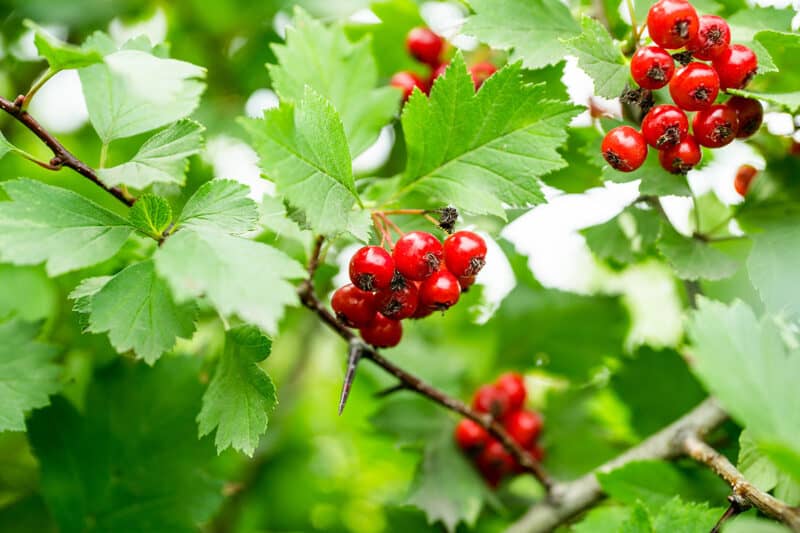
Hawthorns are gorgeous, with beautiful clusters of pink or white flowers in the spring. They stay fairly compact, reaching between 15-30 feet.
As you might have guessed from the name, these trees have thorns, and they serious! They are hard, sharp, and up to four inches long. Some people even have an allergic reaction.
The trees send out suckers, so you can end up with an impenetrable hawthorn forest.
Growing Requirements: These trees need well-draining soil and lots of sun. They grow best in zones 4-9.
14. Honey Locust
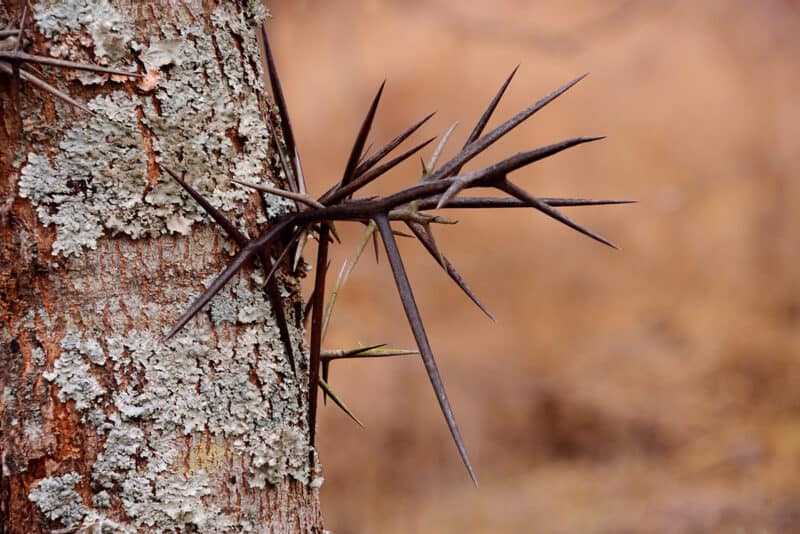
The honey locust (Gleditsia triacanthos) is one mean tree, with thorns on top of thorns. Reminds me of a nightmare I once had.
This is a fast-growing tree that can reach 90 feet in height. Because it can grow so big, use as a windbreak where you don’t want people or animals to enter your property.
The young plant develops into a mass of branches filled with thorns unless you prune it to encourage a single trunk. If you do train it like this, there is no way anyone will climb it to get a vantage point on your property.
Make sure you use good leather gloves and eye protection when working near this tree.
Growing Requirements: Good in zones 5 to 8. Honey locust needs full sun and light, loamy soil that has excellent drainage.
15. Japanese Quince

Japanese quince (Chaenomeles japonica) is beautiful, with bright, showy flowers in the spring. In the fall, the fruit can be cooked into delicious jams and jellies.
This is a good option if you need a smaller plant that stays under 3 feet tall. Perfect if you want something under a window to prevent intruders.
Growing Requirements: This plant grows in zones 5 through 9. It can tolerate partial shade, but you’ll get more flowers and fruit if you give it full sun.
16. Juniper

You might not think of a juniper as a defensive plant, but once you’ve tried to wade your way through a tightly-packed thatch of evergreens, you’ll realize how tough they can be.
They have prickly needles, though the plants do soften with age. Still, if you plant them close together, they can be extremely difficult and painful to try to walk through.
Plus, you can eat the berries on some varieties!
Growing Requirements: Junipers need a sunny spot with well-draining soil. There are tons of varieties, and you can find ones that grow in zones 3-10.
17. Mesquite

Mesquite (Prosopis grandulosa) is native to many parts of the US. The plants have two-inch spikes, a rugged, twisted trunk, and small blue-green leaves.
If you have a south-facing cement wall on your house where everything else seems to get scortched, mesquite is the perfect plant to keep intruders away.
Growing Requirements: Plants grow in zones 6 to 9, while some South American varieties can handle zones 9 to 11.
These plants need low humidity and they don’t mind a ton of heat.
18. Oregon Grape

Oregon grape (Mahonia spp.) are evergreen plants with holly-like leaves. The foliage is glossy, pointed, and extremely prickly. If you’ve ever tried to prune this plant, you know how painful it can be.
Beyond the fact that this bush forms an impenetrable barrier, it has pretty yellow blooms in the spring.
Oregon grape is mostly grown as an ornamental, particularly for adding winter interest to a garden, but don’t forget that you can eat the grape-like berries.
If you want to create a natural fence that keeps both animals and unwanted humans out, this is a good option. It’s particularly good if you need something to fill a narrow space since it grows tall and narrow.
Growing Requirements: In zones 5-9, you can grow this plant in full sun or part shade. Partial shade is preferred in hot regions. This plant prefers regularly moist soil with good drainage.
19. Pyracantha
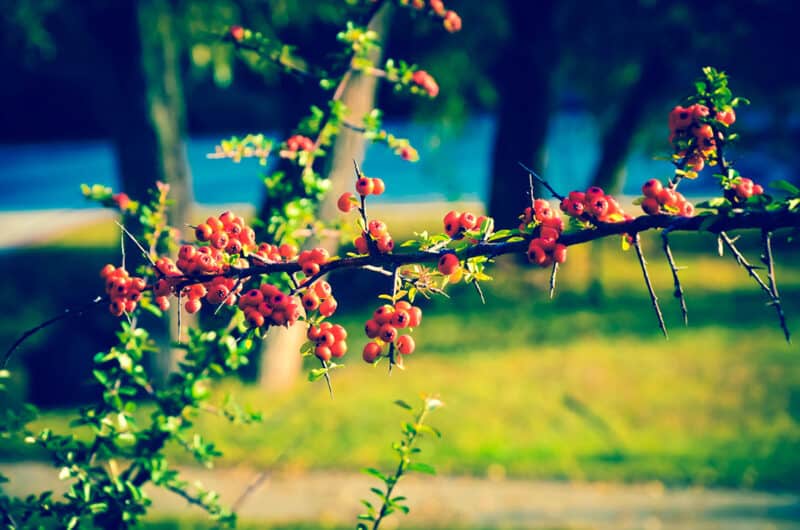
Also known as firethorn, pyracantha (Pyracantha coccinea) is a quick-growing, easy to shape into a hedge, and dense. It has sharp thorns growing along the branches.
If you prune pyracantha into a hedge, you can use it as a perimeter defensive plant. If you allow it to grow without pruning, grow it up walls, fences, or a trellis as a spiky deterrent.
Pyracantha looks attractive with white flowers in spring and orange or red berries in fall.
Some small varieties grow to the height of four to six feet, with a similar spread. Larger varieties grow to 12 feet. Either way, you can grow an effective home security defensive plant.
Growing requirements: This grows well in zones 5 to 9.
Pyracantha isn’t a fussy plant but having well-draining soil and a site in full sun makes it happiest.
20. Prickly Pear
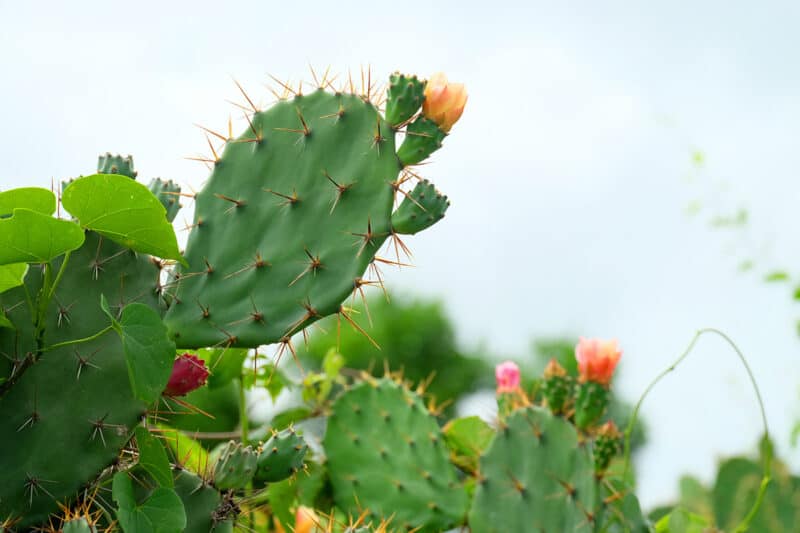
Prickly pear (Opuntia spp.) is a cold-tolerant cactus in the United States and has that classic cactus shape that many people picture in their minds when they think of the West.
This plant has two lines of defense. First is the obvious rows of thorns that will stick in your skin and clothing. Second is the fine hair-like fibers that dig into you and are near impossible to remove. They hurt just as much as the big spikes.
There are low, medium, and high growing prickly pear, so you can plant a multilayered line of defense under windows, against walls, or in wide-open areas you want to stop people from walking through.
Large areas planted with prickly pear, or just one or two plants, look clean and tidy and uninviting to intruders.
Growing requirements: Plant prickly pear in zones 2 to 10. Full sun is imperative and also provide free draining soil.
21. Roses
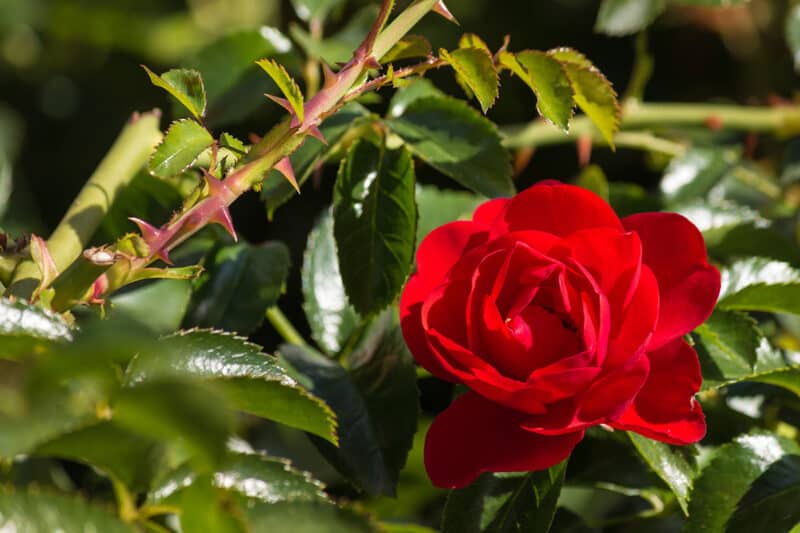
Roses (Rosa) are an incredibly common plant because of their stunning blooms. But they are just as useful for those prickles.
While we normally try to avoid the thorny bits, if you’ve ever tried to prune a rose in a t-shirt, you know what a challenge it can be.
Plant these tightly packed along a fence or under your window and you can be pretty sure that no one is going to try to push their way through.
Growing Requirements: There are many different varieties of roses, and they all have different growing requirements.
There are roses that grow in full sun and some that can handle partial shade. Some roses climb and others crawl along the ground.
You can find cultivars that grow in zone 3 and up to zone 10.
They all need well-draining soil. Make sure you don’t pick a type that is thornless.
Tips for Using Defensive Plants
- Don’t block emergency exits or exits where you may need to leave in a hurry.
- Plan your defensive planting well. Some of these plants will get away from you if not maintained and pruned regularly.
- Be wary of planting where children or pets play or congregate, or you’ll spend a lot of time removing prickles, spikes, and thorns.
- When deciding on plant type for vulnerable spaces, think like an intruder. What would cause you to abandon any attempt to get in through a space where there is a defensive plant and move on to an easier target?
Defensive plants can be extremely effective when used as protection for land and buildings. You just need to choose the right ones and keep on top of the condition and pruning to maintain their effectiveness.
